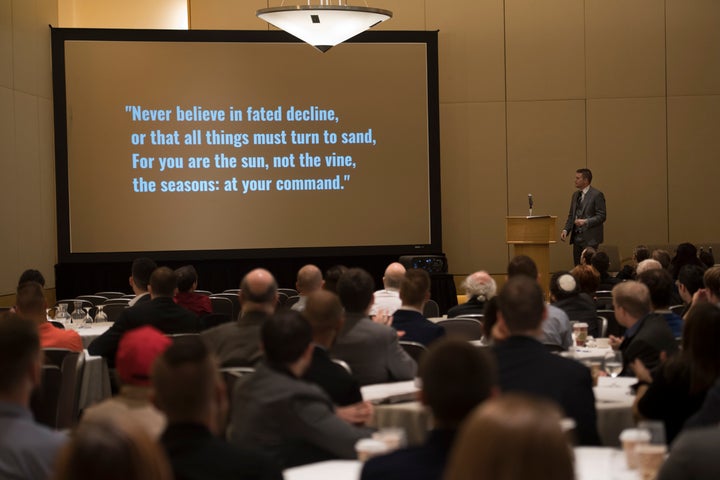
Over the weekend, a group of white nationalists, emboldened by the election of Donald Trump, descended upon Washington to celebrate having taken one step closer to having their crypto-fascist ideology mainstreamed. The occasion was a meeting of the National Policy Institute, a benign name for an organization, headed by Richard Spencer, that essentially traffics in white-supremacist dogma and neo-Nazi cosplay.
As The Huffington Post’s Dana Liebelson and Matt Ferner noted on Friday, white nationalists endeavored “throughout the presidential campaign to sanitize their language to appeal to mainstream voters.” The weekend gathering gave the media a chance to resist this attempt at sanitization.
How did they do? Let’s find out!
The New York Times: “Alt-Right Exults in Donald Trump’s Election With A Salute: ‘Heil Victory’”
Reporter Joseph Goldstein opened with a bit of a scene-setting feint, but didn’t pull his punch, getting right down to business in a third paragraph that showed what happened when, after “11 hours of speeches and panel discussions,” Spencer allowed his polite mask to drop:
But now his tone changed as he began to tell the audience of more than 200 people, mostly young men, what they had been waiting to hear. He railed against Jews and, with a smile, quoted Nazi propaganda in the original German. America, he said, belonged to white people, whom he called the “children of the sun,” a race of conquerors and creators who had been marginalized but now, in the era of President-elect Donald J. Trump, were “awakening to their own identity.”
As he finished, several audience members had their arms outstretched in a Nazi salute. When Mr. Spencer, or perhaps another person standing near him at the front of the room — it was not clear who — shouted, “Heil the people! Heil victory,” the room shouted it back.
Goldstein would re-emphasize this point later in the piece: “But as the night wore on and most reporters had gone home, the language changed.”
Overall it took three paragraphs to get to the overt Nazi ideology and literal Nazi salutes. If the piece has any flaws, it is the use of the term “alt right” in the headline, which is critical to mainstreaming this movement.
The Washington Post: “After Trump victory, attendance rises at annual white nationalist conference in D.C.”
A solid opening paragraph from reporters Steve Hendrix and John Woodrow Cox:
White nationalists from around the country gathered Saturday in downtown Washington to bask in Donald Trump’s victory and celebrate what many proclaimed as a coming-out moment in their mission to turn back multiculturalism and eventually create a whites-only “ethno-state” in North America.
Overall, the piece treats the notion that this group warrants normalization with a high degree of skepticism, and ties specific actions already taken by the Trump transition team ― such as naming Sen. Jeff Sessions (R-Ala.) to run the Department of Justice ― as indicative of like-mindedness with this white nationalist movement.
The Los Angeles Times: “White nationalists dress up and come to Washington in hopes of influencing Trump.”
Easily the worst of the lot, Lisa Mascaro’s piece originally presented Spencer’s organization as a “think tank” and treated the gathering as a whole as if some exciting new smartphone app was being launched. It took five paragraphs for Mascaro to use the term, “white nationalist.” Her buildup to that moment went a long way to normalizing the members of the movement, describing them as “buttoned-down millennials” with a flashy (if fashy!) haircut, “cradling” cups of coffee and going about their “wonky” ways.
Inside a beige meeting room at the Ronald Reagan Building and International Trade Center, the buttoned-down millennials, in their dark suits and ties, settled in for the long conference day ahead.
Like countless others who travel to Washington, they had come to position their interests at the forefront of the political agenda. Their sponsor had a wonky and nondescript name, National Policy Institute. They cradled cups of morning coffee.
But on closer look, this group Saturday was different: They were almost entirely young men, many sporting the same haircut of short sides and back with a familiar flop on top.
The agenda topics: “Trump and the New White Voter,” “America and the Jewish Consciousness,” “The Future of the Alt-Right.”
This will be the account that white nationalists will clip for themselves. I’d wager that The New York Times’ Goldstein reference to reporters who went home early included Mascaro. (Not before getting a rock-star glam-shot of Richard Spencer, however.)
The Guardian’s piece mostly avoids euphemisms in its presentation, with the sub-headline reading, “The ‘alt-right’ conference in Washington wasn’t a gathering of forgotten white working class. It was a white nationalist movement buoyed by millennials.” That’s a pretty laudable effort to separate this band of outsiders from the voters with whom the media actually does need to forge a connection.
Reporter Adam Gabbatt, however, gets stuck in a waddle of throat-clearing toward the top of his piece, unfortunately ― most notably substituting the term “nationalist” for “white nationalist.”
Some of the most prominent members of the so-called “alt-right”, the white nationalist movement that helped propel Donald Trump to the presidency, gathered in Washington DC on Saturday to plot how the movement can “start influencing policy and culture” under the Trump administration.
There was a celebratory mood as Richard Spencer, the president of the National Policy Institute, a nationalist thinktank which hosted the day-long conference, talked about how the “alt-right” would be an “intellectual vanguard” for Trump and the rightwing at large.
But to an outsider, the conference merely served as a shocking insight into the racism, sexism and disturbing beliefs of the “alt-right”.
Gabbatt would, in the next paragraph, go on to describe the “series of Nazi salutes” made by attendees, but without the Guardian’s strong article presentation, readers would not have been properly introduced to the group’s white nationalist identity until the eighth paragraph.
The Huffington Post: “The ‘Alt-Right’ Is A Hate Movement, And It’s Scarier Than You Think”
I’ll let readers be the judge as to whether we did a good job. Per The Huffington Post’s Eliot Nelson:
If you want to know why the unabashedly racist and Nazi-sympathizing “alt-right” movement is making a mark on the Trump administration and beyond, look no further than Tila Tequila and her white nationalist friend, Richard Spencer.
In one of the more bizarre and scary things to transpire in an already bizarre and scary political season, Tequila ― the social media presence, former TV host and current porn star ― attended a conference of white nationalists in Washington this weekend. On the surface, it was odd that the Vietnamese-American, born Thien Thanh Thi Nguyen, was there. Yet her presence squared perfectly with Spencer’s political and messaging strategy, and that of his National Policy Institute, which organized the event.
“The alt-right is willing to work with allies of color,” Spencer told journalists on Saturday. At that moment, it was hard not to think of Tequila, who had tweeted a photo of herself making the Nazi salute with the caption, “Seig [sic] heil!” the night before.
So there you have it, some praiseworthy work in the mainstream media heap, but lots of room for improvement. Above all, reporters need to remember that glamorizing a movement that lionizes some of the 20th century’s most formidable genocidaires (who were defeated by the people we very recently referred to as “the Greatest Generation”) is a pretty bad look. Richard Spencer has the same haircut as every attacking midfielder in the Premier League. Like his style of dress, it’s not notable.
Referring to the National Policy Institute as “wonky” or a “think tank” goes a long way to obscuring the fact that it is, to this day, ceaselessly peddling a racist vision that hasn’t been updated in any meaningful way in decades. This isn’t wonkishness. These ideas haven’t evolved since the last time society rejected them. All that’s new about this is the marketing, and journalists are supposed to be canny enough to recognize a PR offensive when they encounter them in the wild.
And pursuant to that, remember: “alt-right” is not a thing. The term you are looking for is “white nationalism.”

~~~~~
Jason Linkins edits “Eat The Press” for The Huffington Post and co-hosts the HuffPost Politics podcast “So, That Happened.” Subscribe here, and listen to the latest episode below.
